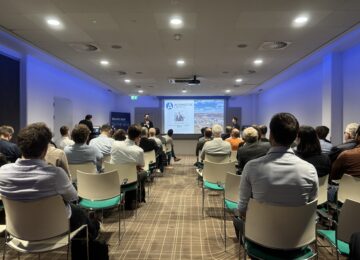Energy storage under the microscope: Risks, regulations and insurability of EOS
ESNL, in partnership with the Association of Insurers, hosted a Webinar on Jan. 23, 2025. under a magnifying glass organized for insurance brokers. Together with Tom Hessels (NIPV), Evert Raaijen (Alfen and ESNL member) and Nienke ten Hagen (NN), the Association dove into the depths of the subject. Hessels focused on the risks, while Raaijen zoomed in on the PGS37-1 guideline.
What are the risks of an EOS?
An energy storage system (EOS) is basically a battery in which electricity is temporarily stored for later use. These systems often contain many small batteries, inverters, air conditioners and sometimes a fire suppression system. Tom Hessels of the Netherlands Institute for Public Safety (NIPV) emphasizes that although the likelihood of incidents is small, the risks if a fault occurs can be serious. The most common incidents are fires and explosions due to so-called "thermal runaway," in which a battery overheats and causes a chain reaction. This can lead to serious damage and even casualties.
Fire hazards and preventive measures
Although the probability of serious incidents is low, it is important to take precautions. According to the PGS37-1 directive, standard measures such as sufficient distance between storage systems, emergency plans, and lightning protection must be taken. In case of incidents, storage systems should also be able to automatically sound an alarm to the local fire department, as was the case in an incident in Drogenbos, where an EOS went into thermal runaway.
The PGS37-1 guideline: what is it and how does it contribute to safety?
Evert Raaijen of Alfen and also an ESNL member, who is involved in the development of the PGS37-1 guideline, explains that it helps set safety standards for the installation of lithium energy storage systems larger than 20 kWh. The PGS37-1 provides clear guidelines for the design, placement and operation of these systems, minimizing the risk of incidents.
The future of energy storage and regulation
The energy transition is accelerating, and there is increasing demand for energy storage systems to maintain the balance between electricity supply and demand. For example, solar power is only available during the day, and wind power depends on weather conditions. Energy storage provides the solution to absorb these fluctuations and optimize the integration of renewable energy sources.
The PGS37-1 directive plays a crucial role here by ensuring the safe and well-regulated deployment of these systems. Raaijen points out that we must remain alert and continue to learn from previous incidents to further improve safety.
Insure energy storage systems
Nienke ten Hagen of Nationale-Nederlanden (NN) stresses the importance of insurability in the energy transition. NN supports the energy transition by embracing innovations and helping customers make their businesses more sustainable. Larger storage systems (>20 kWh) are subject to the PGS37-1 guideline, which helps insurers minimize risk. Ten Hagen distinguishes between home batteries and larger storage systems, saying customization is often necessary for the larger systems to properly insure them.
The rules and how they affect the future
The energy transition calls for new regulations and standards to ensure the safety of energy storage systems. The Netherlands is a leader in this, but Hessels warns that it is important not to introduce too many regulations that hinder innovation. At the same time, we must learn from international experiences, such as the U.S. standard UL9540A, which is constantly being updated based on previous incidents.
Conclusion: secure energy storage is essential for the future
The deployment of energy storage systems is crucial to the energy transition, but it is essential to properly understand and manage the risks. The PGS37-1 guideline provides the necessary guidance to safely install and operate these systems. By sharing knowledge, innovating safely and complying strictly with regulations, we can not only accelerate the energy transition, but also implement it safely and in a well-regulated manner.
Interested in the latest developments? Sign up with ESNL and join the safety working group!
Read the full articles below:
https://www.verzekeraars.nl/publicaties/actueel/eos-onder-een-vergrootglas-1
https://www.verzekeraars.nl/publicaties/actueel/eos-onder-een-vergrootglas-2





